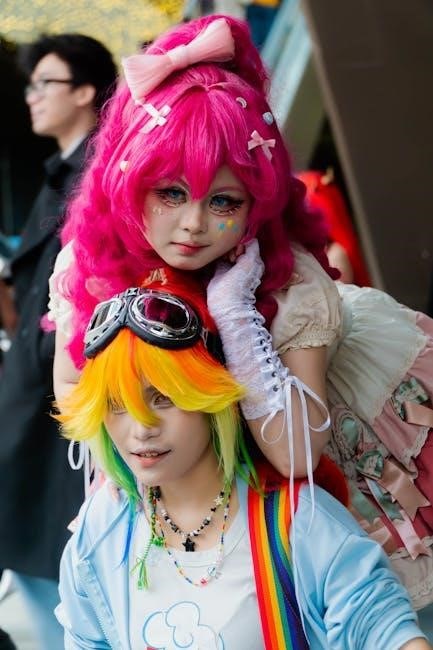The Manga Guide to Linear Algebra offers an innovative, story-driven approach to mastering linear algebra through engaging visuals and relatable characters, making complex concepts accessible and fun for students.
Overview of the Manga Guide Series
The Manga Guide Series is an innovative collection of educational books that blend storytelling with complex subjects like biochemistry, relativity, calculus, and linear algebra. Each title uses engaging narratives and colorful visuals to make daunting topics approachable. Aimed at students and enthusiasts, the series simplifies concepts through relatable characters and real-world applications. Produced by Trend-Pro Co., with contributions from authors like Shin Takahashi and illustrators such as Iroha Inoue, the series has gained popularity for its unique teaching style. This approach has proven effective in helping learners grasp difficult material in an enjoyable and interactive manner, making it a valuable resource for education.
Target Audience and Learning Style
The Manga Guide to Linear Algebra is primarily aimed at high school and university students struggling with traditional textbooks or seeking a more engaging introduction to the subject. Its visual and narrative approach caters to visual learners and those who find abstract concepts challenging. The series is designed to be accessible, making it ideal for beginners or as a supplement to formal education. By combining storytelling with technical content, it creates an interactive learning experience that breaks down complex ideas into relatable scenarios. This unique format helps students build a strong foundation in linear algebra while keeping them motivated and entertained.
Unique Approach to Teaching Linear Algebra
The Manga Guide to Linear Algebra employs a groundbreaking method by blending comics with mathematical concepts, transforming abstract ideas into engaging, real-world scenarios. This approach uses visual storytelling to simplify complex topics like vector operations and matrix manipulations, making them intuitive and memorable. By integrating relatable characters and narratives, the guide creates an interactive learning experience that keeps students engaged. The use of vivid illustrations and practical examples, such as miniature golf games, helps learners visualize abstract principles. This innovative technique not only simplifies linear algebra but also makes it enjoyable, allowing students to grasp difficult concepts through a hands-on, visually driven approach.

Narrative and Storytelling in The Manga Guide
The Manga Guide to Linear Algebra uses a story-driven narrative, following characters like Reiji and Misa as they explore linear algebra concepts through engaging, relatable scenarios.
Protagonists and Their Roles in Learning
The Manga Guide to Linear Algebra features Reiji, a determined math student, and Misa, his companion, as the central characters guiding readers through the subject. Reiji serves as both a student and teacher, breaking down complex concepts into relatable scenarios. Misa’s curiosity and questions mirror those of the reader, creating an interactive learning experience. Their dynamic interaction simplifies abstract ideas, such as vector operations and matrix manipulations, into engaging narratives. Through their journey, the manga transforms linear algebra into a story-driven adventure, making it accessible and memorable for learners at all levels.

Comic-Style Explanations of Complex Concepts
The Manga Guide to Linear Algebra uses vibrant, full-color comics to simplify complex mathematical ideas. Through visually engaging storylines, abstract concepts like vector spaces, linear transformations, and determinants are transformed into relatable scenarios. For example, vector operations are illustrated through miniature golf games, while matrix manipulations are explained using karate tournaments. These visual metaphors make challenging topics more intuitive and easier to grasp. The combination of narrative and imagery ensures that readers can follow along without feeling overwhelmed, making even the most abstract ideas in linear algebra accessible and engaging;
Engaging Through Visual and Narrative Elements
The Manga Guide to Linear Algebra captivates readers with its dynamic combination of visuals and storytelling. Through the adventures of Reiji and Misa, complex topics like vector spaces and linear transformations are woven into relatable narratives. The manga’s vibrant artwork and character-driven plot make abstract concepts feel tangible and fun. For instance, vector operations are illustrated through miniature golf games, while matrix manipulations are explained using karate tournaments. These visual and narrative techniques create an immersive learning experience, ensuring that readers stay engaged and motivated throughout their journey into the world of linear algebra.

Key Concepts Covered in The Manga Guide
The Manga Guide to Linear Algebra explores vector operations, matrices, linear independence, systems of equations, vector spaces, linear transformations, determinants, and eigenvalues in an accessible format.
Vector and Matrix Operations
The Manga Guide to Linear Algebra introduces vector and matrix operations through engaging storytelling and visual explanations. Vectors are explained as geometric entities, while matrices are presented as arrays of numbers with specific properties. The manga uses relatable scenarios, such as miniature golf games, to illustrate how vectors add and scalar multiplication works. Matrix operations, including addition, subtraction, and multiplication, are broken down into simple, digestible steps. Characters like Reiji and Misa guide readers through these concepts, making abstract ideas concrete and fun. The visual format helps learners grasp how vectors and matrices interact, providing a strong foundation for more advanced topics in linear algebra.

Linear Independence and Dependence
The Manga Guide to Linear Algebra simplifies the concept of linear independence and dependence through engaging visuals and storytelling. Using relatable examples, such as vectors in geometric spaces, the manga illustrates how sets of vectors can be independent or dependent. The narrative explores how adding or removing vectors affects their independence, making abstract ideas intuitive. Characters like Reiji and Misa encounter real-world scenarios, such as solving systems of equations, where understanding these concepts is crucial. The visual format and step-by-step explanations help learners grasp the practical implications of linear independence and dependence, ensuring a solid understanding of these fundamental ideas in linear algebra.
Systems of Linear Equations
The Manga Guide to Linear Algebra creatively explains systems of linear equations through visual storytelling and relatable scenarios. Reiji and Misa tackle problems by representing equations as matrices and exploring methods like elimination and substitution. The manga uses engaging examples, such as solving for unknowns in geometric configurations, to illustrate how systems can be consistent, inconsistent, or dependent. Visual breakdowns of matrix operations and determinants help learners understand how to approach and solve these systems practically. The narrative makes abstract concepts like solution sets and free variables more tangible, ensuring readers grasp the importance of systems of equations in real-world applications.
Vector Spaces and Subspaces
The Manga Guide to Linear Algebra presents vector spaces and subspaces in an engaging, visual format, making these abstract concepts more approachable. Through the narrative, Reiji and Misa explore vector spaces as collections of vectors that can be scaled and added together, and subspaces as special subsets within them. The manga uses geometric interpretations and real-world analogies to clarify ideas like span, dimension, and orthogonality. By illustrating how subspaces inherit properties from their parent spaces, the guide helps readers understand their significance in structuring and solving linear algebra problems. This visual and narrative approach ensures a deeper, intuitive grasp of these fundamental concepts.
Linear Transformations and Matrices
The Manga Guide to Linear Algebra creatively explains linear transformations and matrices through engaging visuals and storytelling. It depicts transformations as mappings between vector spaces, emphasizing their role in operations like rotations and scaling. Matrices are introduced as tools for representing these transformations, with characters using them to solve practical problems. The guide uses relatable analogies and visual examples to clarify key concepts, ensuring readers grasp how matrices facilitate computations in linear algebra. By integrating narrative and visuals, the manga makes these fundamental ideas accessible and memorable, helping learners connect abstract math to real-world applications.
Determinants and Eigenvalues
The Manga Guide to Linear Algebra simplifies determinants and eigenvalues through engaging narratives and visuals. It explains determinants as scalar values reflecting matrix properties, with geometric interpretations like area scaling. Eigenvalues are introduced as solutions to specific matrix equations, with characters using them to analyze transformations. The manga uses relatable scenarios, such as karate tournaments, to illustrate eigenvalue concepts, making abstract ideas intuitive. By blending storytelling with mathematical rigor, the guide ensures readers grasp these essential topics in linear algebra, preparing them for practical applications in fields like computer graphics and engineering.

Learning Approach and Structure
The Manga Guide to Linear Algebra combines comics and practice problems for a user-friendly, structured learning experience, simplifying complex concepts through engaging visuals and hands-on exercises.
Manga as a Teaching Tool
The Manga Guide to Linear Algebra uses a story-driven approach, blending narrative with visual explanations to make complex mathematical concepts more relatable and engaging. By following the adventures of characters like Reiji and Misa, readers are introduced to linear algebra through a series of real-world scenarios and visual metaphors. The manga format breaks down abstract ideas into digestible chunks, using illustrations to simplify concepts such as vector operations and matrix transformations. This unique teaching tool not only engages visual learners but also provides a fun and interactive way to grasp theoretical principles, making it an effective supplement to traditional textbooks.
Chapter-by-Chapter Breakdown
The Manga Guide to Linear Algebra is structured into chapters that progressively build upon foundational concepts, starting with basic vector and matrix operations. Each chapter begins with a manga section that introduces the topic through a narrative, followed by detailed explanations and practice problems. Key chapters cover linear independence, systems of linear equations, vector spaces, and linear transformations. The guide also delves into advanced topics like determinants and eigenvalues, using visual storytelling to simplify complex ideas. This chapter-by-chapter approach ensures a logical flow, making it easier for readers to grasp each concept before moving on to the next. The format combines education with entertainment, enhancing retention and understanding through engaging visuals and real-world applications.
Practice Problems and Exercises
The Manga Guide to Linear Algebra includes a variety of practice problems and exercises to reinforce learning. Each chapter concludes with a set of problems that range from basic drills to more complex applications, ensuring a deep understanding of concepts like vector operations, matrix multiplication, and systems of linear equations. The exercises are designed to be approachable, with clear instructions and solutions provided to help students check their work. Real-world examples, such as calculating scores in miniature golf or analyzing tournament rankings, make the problems relatable and engaging. This hands-on approach complements the manga narrative, allowing readers to apply what they’ve learned and solidify their grasp of linear algebra fundamentals.
Real-World Applications of Linear Algebra
The Manga Guide to Linear Algebra highlights practical uses of the subject in various fields, such as computer graphics and data analysis. Through relatable examples like miniature golf games and karate tournaments, the manga demonstrates how linear algebra solves real-world problems. Readers learn how concepts like vector spaces and matrices apply to diverse scenarios, making the subject more engaging and relevant. This approach helps students and professionals alike appreciate the importance of linear algebra in modern applications, from scientific computing to engineering, while keeping the content accessible and enjoyable through its unique storytelling style.

Reception and Reviews
The Manga Guide to Linear Algebra has gained popularity among students for its engaging storytelling and visual explanations, receiving positive feedback from both academic and professional circles.
Popularity Among Students

The Manga Guide to Linear Algebra has become a favorite among students due to its engaging storytelling and visual explanations. Many find it easier to grasp complex concepts through the relatable characters and real-world examples; The book’s unique blend of humor and education makes it a refreshing alternative to traditional textbooks. Students appreciate how it breaks down abstract ideas into digestible parts, making linear algebra feel less intimidating. Its popularity stems from its ability to connect with learners on a personal level, fostering a deeper understanding and enjoyment of the subject. This approach has led to positive word-of-mouth and widespread use among undergraduate students.
Academic and Professional Feedback

Academics and professionals have praised The Manga Guide to Linear Algebra for its innovative approach to teaching complex mathematical concepts. Educators appreciate how the book simplifies abstract ideas through visual storytelling, making it an excellent supplementary resource for students. Professionals have noted its ability to refresh their understanding of linear algebra in an engaging and non-traditional way. The book’s clarity and accessibility have made it a valuable tool for both beginners and those looking to reinforce their knowledge. Its unique format has been commended for bridging the gap between entertainment and education, proving that complex subjects can be taught in an enjoyable manner.
Comparison to Traditional Textbooks
The Manga Guide to Linear Algebra stands out as a refreshing alternative to traditional textbooks, offering a visually engaging and story-driven approach. Unlike dense, formula-heavy texts, it uses relatable characters and real-world analogies to explain complex concepts. The manga format makes learning feel less intimidating, allowing readers to grasp abstract ideas through visual storytelling. While traditional textbooks focus on theoretical depth, this guide prioritizes accessibility and entertainment, making it an excellent supplementary resource. Its unique blend of humor, visuals, and narrative ensures that even the most challenging topics remain engaging and memorable for learners of all levels.

Creators and Contributors
Shin Takahashi authored the guide, with illustrations by Iroha Inoue and production by Trend-Pro Co., combining expertise and creativity to make linear algebra engaging and accessible.
Shin Takahashi and Iroha Inoue
Shin Takahashi, the author, and Iroha Inoue, the illustrator, collaborated to create The Manga Guide to Linear Algebra. Takahashi’s expertise in mathematics shines through the narrative, while Inoue’s artwork brings concepts to life. Their partnership ensures the guide is both informative and visually appealing. Known for making complex topics accessible, Takahashi’s writing is clear and engaging, complemented by Inoue’s dynamic illustrations. Together, they transform abstract algebra into relatable stories, helping students grasp key ideas through memorable characters and scenarios. Their work has been praised for its unique blend of education and entertainment, making linear algebra approachable for learners worldwide.
Role of Trend-Pro Co. in Production
Trend-Pro Co. played a pivotal role in the production of The Manga Guide to Linear Algebra, serving as the publisher and creative overseer. Their expertise ensured the seamless integration of mathematical content with engaging manga storytelling. The company collaborated closely with author Shin Takahashi and illustrator Iroha Inoue, providing editorial support and design guidance. Trend-Pro Co. was instrumental in refining the narrative and visual elements, ensuring clarity and accuracy in presenting complex linear algebra concepts. Their production team handled layout, printing, and distribution, making the guide accessible to a global audience. Their involvement was crucial in transforming the vision into a polished, educational product.
The Manga Guide to Linear Algebra successfully blends storytelling with visual explanations, making complex concepts engaging and accessible for students of all levels.
Final Thoughts on The Manga Guide
The Manga Guide to Linear Algebra is a groundbreaking resource that simplifies complex mathematical concepts through engaging storytelling and visuals. By blending relatable characters with clear explanations, it makes linear algebra accessible to students who struggle with traditional textbooks. The guide effectively balances fun and education, ensuring readers grasp key ideas without feeling overwhelmed. Its unique approach, combining manga-style narratives with step-by-step lessons, creates a memorable learning experience. While it may not replace formal textbooks, it serves as an excellent supplementary tool for visual learners and those seeking a fresh perspective. This guide proves that even abstract topics can be made engaging and understandable through creative storytelling.
Recommendations for Further Study
After exploring The Manga Guide to Linear Algebra, students can deepen their understanding by transitioning to traditional textbooks for more rigorous mathematical detail. Exploring real-world applications, such as computer graphics or machine learning, can contextualize the concepts. Supplementing with online resources, like video tutorials or interactive tools, can reinforce learning. Additionally, other titles in the Manga Guide series, such as calculus or relativity, offer a similar engaging approach to related subjects. For those seeking hands-on practice, solving problems from standard linear algebra textbooks or participating in coding projects can further solidify comprehension. This blend of resources ensures a well-rounded mastery of the subject.
